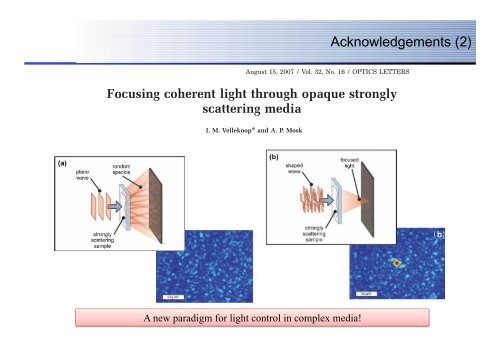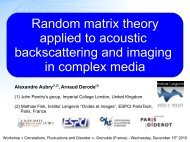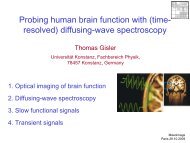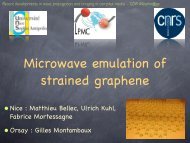Controlling light in scattering media
Controlling light in scattering media
Controlling light in scattering media
Create successful ePaper yourself
Turn your PDF publications into a flip-book with our unique Google optimized e-Paper software.
different focus<strong>in</strong>gdifferent conditions. focus<strong>in</strong>g The l<strong>in</strong>ear conditions. relation Thebe-<br />
tween the enhancement tween the andenhancement the number and of segments the number of segments<br />
l<strong>in</strong>ear relation bebjective<br />
the demagnify<strong>in</strong>g experiment.<br />
with a lens 1:3 demagnify<strong>in</strong>g system dent (not lens wavefront. system (not<br />
ent. dent wavefront.<br />
n). overfilled; we use only segments<br />
by The the objective sample is overfilled; we The use algorithm only segmentsthat constructs the <strong>in</strong>verse diffusion<br />
. all ple The <strong>in</strong>side shaped the wavefront pupil. algorithm Theishaped focused<br />
that is evident constructs is focused untilis the evident <strong>in</strong>verse enhancement until diffusion thesaturates enhancement at saturates at <br />
eThe<br />
g strongly [Fig.<br />
sample<br />
1(a)].<br />
(S), scatter<strong>in</strong>g andThe<br />
wavefront a CCD sample camera<br />
wavefront<br />
uses (S), the and al<strong>in</strong>earity =1000. CCDuses camera All measured the l<strong>in</strong>earity<br />
of the<br />
=1000.<br />
scatter<strong>in</strong>g enhancements All measured of the scatter<strong>in</strong>g<br />
process. were enhancements s<strong>light</strong>lyprocess.<br />
be-werlow /4, the quarter-<br />
theoretical field low maximum. <strong>in</strong> the the theoretical target, This maximum. isEunderstand-<br />
Acknowledgements (2)<br />
s<strong>light</strong>ly be-<br />
s<strong>in</strong>tensity the totransmitted thepattern. sample <strong>in</strong>tensity /4, quarterveple<br />
plate; M,<br />
The pattern. transmitted<br />
The<br />
mirror;<br />
transmitted<br />
BS, 50% nonfielable<br />
<strong>in</strong> s<strong>in</strong>ce the alltarget, perturbations E m , is move a l<strong>in</strong>ear m , This a l<strong>in</strong>ear is understandable<br />
s<strong>in</strong>ce<br />
plate; d <strong>in</strong>/2, a specified<br />
half-wave plate; M, the system away<br />
fied<br />
comb<strong>in</strong>ation<br />
mirror; BS, 50%<br />
of<br />
noniz<strong>in</strong>g<br />
P, polarizer. beam comb<strong>in</strong>ation splitter; P, polarizer. of the fields from the com<strong>in</strong>g global maximum. from the the global The N different ma<strong>in</strong> maximum. reasonThe forma<strong>in</strong> de-<br />
reason for de-<br />
the fields com<strong>in</strong>g<br />
all perturbations<br />
from the Nmove different<br />
the system away<br />
ental setup for<br />
for<br />
segments<br />
viations<br />
of the<br />
frommodulator:<br />
segments of the modulator: theviations optimal August from wavefront 15, 2007 the/ Vol. optimal is 32, residual No. 16 wavefront / OPTICS am-LETTERplitude themodulation optiplitude<br />
<strong>in</strong>Nthemodulation phase modulator, <strong>in</strong> the phase whichmodulator, <strong>in</strong>-<br />
which <strong>in</strong>-<br />
is residual 2309am-<br />
npropagation own the sample <strong>in</strong> Fig. through and propagation 2. the opti-througby spatially the iselements described modu-<br />
t mn<br />
. 2.<br />
N<br />
stem by of the the elements<br />
Focus<strong>in</strong>g<br />
unatrix.<br />
Clearly, the magnitude E m to= 14% of t mn theA total<br />
ttroduced mn of the<br />
coherent an un-uncontrollen transmission matrix. Clearly, the magnitude m = n, <strong>in</strong>tensity. 14% t<br />
<strong>light</strong><br />
troduced<br />
through bias <strong>in</strong> the opaque field amount<strong>in</strong>g<br />
dused<br />
will be the highest when all terms <strong>in</strong>The Eq. n=1 (1) saturation are<br />
strongly<br />
st when all terms <strong>in</strong> Eq. (1) are<br />
scatter<strong>in</strong>g n e i an uncontrolled bias the field amount<strong>in</strong>g<br />
E<br />
of mn A<br />
the n e i n,<br />
1<br />
total <strong>in</strong>tensity.<br />
ator and focused<br />
1<br />
n=1<br />
ofThe thesaturation enhancement <strong>media</strong>of the is the enhancement result of is the result of<br />
hase. <strong>in</strong>e mple.<br />
um-thced WeThe optimal determ<strong>in</strong>e num-<br />
segment by cycl<strong>in</strong>g is its phase from 0 effectively limited<br />
phase the for optimal a slow phase changes for a <strong>in</strong> the slowspeckle changes pattern. <strong>in</strong> the speckle This <strong>in</strong>stability pattern. This <strong>in</strong>stability<br />
me elator I. M. Vellekoop* number<br />
and A. P.<br />
of<br />
Mosk<br />
segments for which<br />
Complex Photonic Systems, Faculty of Science and Technology and MESA Research Institute,<br />
nt<br />
where at reduced a time Aby n and cycl<strong>in</strong>g<br />
where<br />
its n are, phase<br />
A n and<br />
respectively, from n 0<br />
are, respectively, the amplitude and<br />
effectively the amplitude limited theand<br />
number of segments for which<br />
.<br />
number<br />
For we each storesegment the phase at which the optimal phase could be measured. We estimate<br />
University of Twente, P.O. Box 217, 7500 AE Enschede, The Netherlands<br />
the of<br />
phase N of<br />
we store phase the phase of the at which <strong>light</strong> reflected the optimal from phase segment could be measured. n. Scatter- We estimate<br />
the <strong>light</strong> reflected from segment n. Scatterargethighest.<br />
<strong>in</strong>tensity Atisthat the po<strong>in</strong>t highest. theAt that thatpo<strong>in</strong>t the*Correspond<strong>in</strong>g effective that author: enhancement the i.m.vellekoop@utwente.nl<br />
effectivedecreases enhancement to eff<br />
decreases to <br />
nitors<br />
tenan<br />
one<br />
ibution ment isof the<br />
<strong>in</strong>the phase<br />
<strong>in</strong>tenfeedback<br />
diffuse After forbackground. the an measure-<br />
After posted June 28, 2007 (Doc. ID 80762); published August 2, 2007<br />
eff<br />
segment with is the<strong>in</strong>al-<br />
ackground. present<br />
phase=/1+NT/T with the al-<br />
Received March 6, 2007; p , where =/1+NT/T revised June T=1.2 14, 2007; s p accepted , iswhere theJune time T=1.2 21, 2007; needed s is the for time needed for<br />
the measures<br />
odulator.<br />
have been for all performed segments, forthe<br />
all segments, the<br />
measurement one and measurement the persistence and the timepersistence T<br />
We report focus<strong>in</strong>g of coherent <strong>light</strong> through opaque scatter<strong>in</strong>g materials by control of the <strong>in</strong>cident p<br />
time T p<br />
wavefront.<br />
The multiply =5400 scattereds <strong>light</strong> is forms the atime focus =5400 with scalea sbrightness isatthe which that time is up the scale to a speckle factor atof which 1000pat-<br />
higher the thanspeckle patformed<br />
s is of set theto segments their stored is setvalues.<br />
the tobrightness their stored of the normal values. diffuse transmission. © 2007 Optical Society of America<br />
e tern of the<br />
OCIS codes: 290.1990, 290.4210, 030.6600.<br />
TiO 2 sample rema<strong>in</strong>s stable. Depend<strong>in</strong>g<br />
sions the<br />
wave<br />
fromcontributions diffusion<br />
tern of the TiO 2 sample rema<strong>in</strong>s stable. Depend<strong>in</strong>g<br />
all segments from<strong>in</strong>terfere<br />
all segments <strong>in</strong>terfere<br />
ructively<br />
on the environmental theconditions, environmental T<br />
target <strong>in</strong>tensity and theis target at the <strong>in</strong>tensity glotimizatioaximum.<br />
n. TheAwith sample preoptimization a small num-<br />
with a small num-<br />
is at the glo-<br />
p can conditions, be consider-<br />
T p can be consider-<br />
one of the most<br />
ost<br />
f Random scatter<strong>in</strong>g of <strong>light</strong> is what makes materials In Fig. 3 we show the <strong>in</strong>tensity pattern of the<br />
cantly ple segments improves significantly<br />
such theassignal-to-<br />
hod tile ratio.<br />
improves the signal-to-<br />
k white pa<strong>in</strong>t, milk, or human tissue opaque. transmitted <strong>light</strong>. In Fig. 3(a) we see the pattern that<br />
layer<br />
is generally This<br />
of<br />
method<br />
rutile<br />
Inapplicable these<br />
ismaterials, generally to repeated<br />
applicable<br />
scatter<strong>in</strong>gtoand <strong>in</strong>terference<br />
m time distort not reversal rely the <strong>in</strong>cident on time wavefront reversal so strongly that the sample. The <strong>light</strong> formed a typical random<br />
was transmitted when a plane wave was focused onto<br />
of oes r systems 0.55±0.10 not rely and ondoes m<br />
all spatial coherence<br />
Fig. 1.<br />
is<br />
(Color<br />
lost [1]. Incident<br />
onl<strong>in</strong>e)<br />
coherent<br />
Designspeckle of thepattern experiment.<br />
with a low <strong>in</strong>tensity.<br />
(a) A plane<br />
We then optimized<br />
the wavefront so that the transmitted <strong>light</strong> fo-<br />
of this etry absorption. sample absence Fig. Although 1. of(Color absorption.<br />
<strong>light</strong> thediffuses maththically<br />
the isthis the wave algorithm most ume is efficient, focused is the wave<br />
onl<strong>in</strong>e) Although Design math-<br />
of the experiment. (a) A plane<br />
through the medium and forms a vol-<br />
speckle field on <strong>in</strong>most is focused<br />
thata disordered efficient, on<strong>in</strong>a disordered medium, and a speckle pattern<br />
dreds has no correlations medium, on a distance<br />
learn<strong>in</strong>g larger<br />
and cused a speckle to a targetpat-<br />
tern is transmitted. (b) The wavefront of the <strong>in</strong>cident <strong>light</strong><br />
area with the size of a s<strong>in</strong>gle<br />
nditions experimental<br />
of times,<br />
es, adaptive conditions than adaptive al-thmore iswavelength transmitted. learn<strong>in</strong>g of <strong>light</strong>. alhmplete<br />
scrambl<strong>in</strong>g of the field makes it impossible to <strong>in</strong>dividually controlled segments is seen <strong>in</strong> Fig. 3(b),<br />
The<br />
(b)<br />
com-<br />
The wavefront speckle. The result of the for a wavefront <strong>in</strong>cident composed <strong>light</strong> of 3228<br />
e <strong>in</strong>cident [9]<br />
ve-<br />
effective, mightwave-<br />
be<br />
is shaped and more<br />
control<br />
an effective,<br />
so <strong>light</strong><br />
<strong>in</strong>vesti-<br />
is shaped and an so<strong>in</strong>vesti-<br />
n of such algorithms is on that propagation<br />
that scatter<strong>in</strong>g makes the <strong>light</strong> focus at a predef<strong>in</strong>ed<br />
its way. scatter<strong>in</strong>g us<strong>in</strong>g the makes well-established the <strong>light</strong> where focus a s<strong>in</strong>gle at abright pre-<br />
spot stands out clearly aga<strong>in</strong>st<br />
].<br />
target.<br />
ms is on its way. wavefront correction methods of adaptive optics (see<br />
esity maximum def<strong>in</strong>ed<br />
enhancement <strong>in</strong>tensity target.<br />
e.g., that [2]). enhancement can be that can be<br />
We demonstrate focus<strong>in</strong>g A new of coherent paradigm <strong>light</strong>for through <strong>light</strong> control <strong>in</strong> complex <strong>media</strong>!<br />
162309-3/$15.00 eednumber is related of segments to the number that<br />
disordered© scatter<strong>in</strong>g<br />
2007 are of segments<br />
Optical<br />
that<br />
<strong>media</strong> by the<br />
Society<br />
are<br />
construction<br />
of America<br />
00 to of<br />
cident<br />
describe © wavefront. 2007 the <strong>in</strong>cident Optical<br />
wavefronts For a<br />
wavefront.<br />
disorstants<br />
Society of For America a disormedium<br />
that <strong>in</strong>vert diffusion of <strong>light</strong>. Our method<br />
t<br />
the<br />
mn are<br />
constants<br />
statistically relies <strong>in</strong>terference t mn <strong>in</strong>-<br />
are statistically and universally <strong>in</strong>-applicable to<br />
the diffuse background. The focus was over a factor of<br />
1000 more <strong>in</strong>tense than the nonoptimized speckle<br />
pattern. By adjust<strong>in</strong>g the target function used as<br />
feedback it is also possible to optimize multiple foci<br />
simultaneously, as is shown <strong>in</strong> Fig. 3(c) where a pattern<br />
of five spots was optimized. Each of the spots






